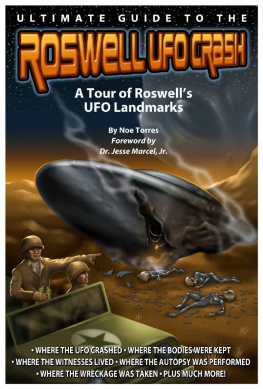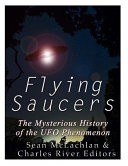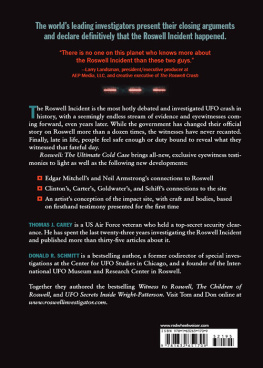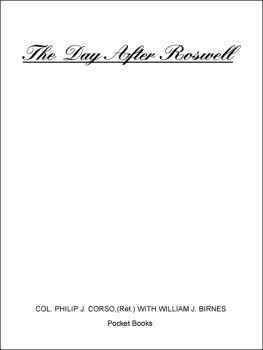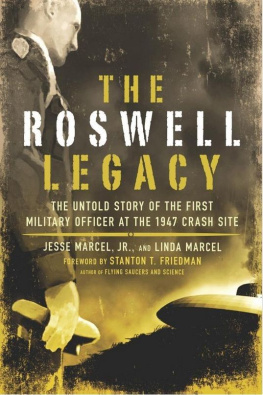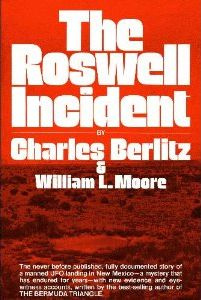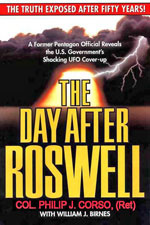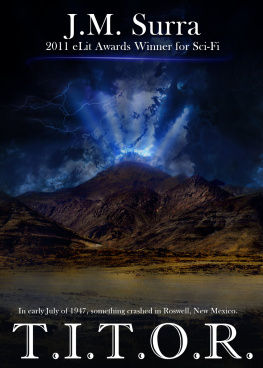FOREWORD
By Jesse Marcel, Jr.
Shortly after taking part in the Bikini Atoll atomic bomb tests in July of 1946, my father was assigned to the Roswell Army Air Field (RAAF), the home base for the 509th Composite Bomb Group, which had ended World War II with the atomic bombing of Japan . He was Major Jesse A. Marcel , the intelligence officer for the 509th, and he had been on the inside of the top secret mission that brought the war with Japan to a close. His military training and experience were extensive, and his role as intelligence officer for the only atomic bomb group in the world was a serious one. Anyone who suggests that my dad wouldnt have been able to identify a downed high-altitude balloon is completely ignorant of his background and his training.
In late 1946, my parents and I moved into RAAF base housing, and, since the base had no school facilities at that time, I attended Mountain View School, located just outside the base, on the way into Roswell. A few months later, in the spring of 1947, we moved into town to a corner lot house located at 1300 West Seventh Street, which looks pretty much the same today as it did all those many years ago. There is a vacant lot still there across the street adjacent to the house where Johnny Peck, one of my close friends, lived. Those spring and early summer days in Roswell were the best times of my life. Gayle Salee, Johnny Peck and I spent many hours bicycling all over Roswell and west into the desert. I have such fond memories of that time of my life, especially the many hours spent playing with friends during the long, hot Roswell summers.
My dad had an office at the Roswell Army Air Field, but he really did not keep regular office hours there, as his job duties routinely required that he work far beyond normal working hours, including nights and weekends. The only time I ever saw where he worked at the RAAF was when he took my mom and me on a tour. What I remember most is a large room where briefing sessions were held for the bomb crews. In that room, I recall seeing a world map that glowed in luminescent hues from ultraviolet lights. All of this was quite impressive to me at the time.
Things went along routinely for the first part of 1947. And then it happened. One night in early July, I recall that my dad did not come home for supper, or if he did, I did not see him. Something seemed odd. I did not see him again until very late the next evening or perhaps even very early in the morning on the day after that. At any rate, when he finally came home, I was asleep in my room and had already been asleep for hours, exhausted from a full day of bicycling with my friends.
I recall my dad waking me up in the middle of the night. He led me into the kitchen where, I think, my mother was already up and looking at a lot of debris scattered on the kitchen floor. Dad was very excited at what was there, but honestly I could not understand what all his excitement was about. To me, the junk strewn on the kitchen floor was just a lot of metal fragments that looked like a foil mixed together with something that seemed to be black plastic and also some metallic-looking beams.
While the debris did not make a great impression on me at first, my dads description of it most certainly did. He told my mother and me that what we were looking at were parts from a flying saucer. Although, still groggy with sleep, the full implications of the phrase flying saucer did not sink it at first, I realized from my dads excited state that this was something extremely unique and important.
My interest was especially piqued when Dad said that I would never see something like this again in my life. The realization suddenly dawned on me that what he was saying is that what we were looking at had come from somewhere besides Earth and that this was part of a machine from another planet.
He instructed us to search very carefully through the wreckage looking for any familiar electronic components, such as vacuum tubes, resistors condensers or wire. In fact, he had already searched the debris for these types of components and had found none, but he wanted us to conduct our own search and satisfy our own curiosities. So, Mom and I dutifully complied with his request and found nothing that looked like conventional electronics in the debris.
Regarding the thin metallic debris that looked like foil, I recall that it seemed similar to todays aluminum wrap, and yet there was a noticeable difference in its appearance and feel. I struggle to adequately explain the exact differences and can only say that it seemed like aluminum wrap but clearly was not.
The strangest parts of the debris were some straight metallic pieces that I have always thought of as I-beams. Marked on one surface of these beams were strange hieroglyphic-like symbols with kind of a violet or purple hue to them. One of these I-beams was 12 to 18 inches long and about three eighths of an inch across (cross sectional width). The beam appeared to be metallic and may have been made of the same material as the foil.
The other material in the debris seemed to be kind of a black plastic, sort of like Bakelite, which was a common material used in the manufacture of countertops at that time. Upon examining this dark material, along with the foil-like material and the I-beams, I was left with the distinct impression that the debris was something very special and certainly not of any common or ordinary composition.
People often ask me, Why didnt you keep some of it? The reason, as simple as it sounds, is that the viewing of the material had been a privilege granted to me by my father, and I knew that his job demanded that he take it the RAAF. The material was not ours to keep and was ultimately the property of the United States Army Air Force. In truth, it never occurred to me to keep any of it, and I guarantee that had I kept any of it, I would not have it now because the military was hell-bent on recovering all of it. First, the army worked to ensure that none of the material fell into civilian hands, and second, if any of it did, they used every resource at their disposal to get it back.

